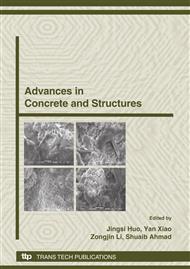[1]
Stark J., Bollmann K., Delayed Ettringite Formation in Concrete, Bauhaus-University Weimar, Germany. Undated. http: /www. itn. is/ncr/publications/doc-23-2. pdf. Date accessed: 19/11/(2007).
Google Scholar
[2]
Mehta K., CONCRETE: Structure, Properties, and Materials, Prentice-Hall, New Jersey, (1986).
Google Scholar
[3]
Gabrisovd A., Havlica J., Stability of Calcium Sulphoaluminate Hydrates In Water Solutions With Various PH Values, Cement and Concrete Research, Vol. 21, pp.1023-1027, (1991).
DOI: 10.1016/0008-8846(91)90062-m
Google Scholar
[4]
Mehta P. K., Mechanism of Sulfate Attack on Portland Cement, Concrete - Another Look, Cement and Concrete Research, Vol. 13, pp.401-406, (1983).
DOI: 10.1016/0008-8846(83)90040-6
Google Scholar
[5]
Mangat P.S., and El-Khatib J.M., Influence of initial curing on sulphate resistance of blended cement concrete,. Cement and Concrete Research, Vol 22 (1992), pp.1089-1100.
DOI: 10.1016/0008-8846(92)90039-x
Google Scholar
[6]
Collepardi M., Collepardi S., Olagot J.J.O., and Troli R., Delayed Ettringite Formation due to Sulfate Cement Content and Curing Temperature, Undated. Accessed at: http: /www. uwm. edu/~ymchun/CBU/Collepardi. DEF. pdf on 05/12/(2007).
DOI: 10.1617/2912143802.015
Google Scholar
[7]
Collepardi M., A state-of-the-art review on delayed ettringite attack on concrete, Cement and Concrete Composites, Volume 25, Issues 4-5, May-July 2003, Pages 401-407.
DOI: 10.1016/s0958-9465(02)00080-x
Google Scholar
[8]
Escadeillas G., Aubert J. -E., Segerer M., and Prince W., Some factors affecting delayed ettringite formation in heat-cured mortars, Cement and Concrete Research, Volume 37, Issue 10, October 2007, Pages 1445-1452.
DOI: 10.1016/j.cemconres.2007.07.004
Google Scholar
[9]
Diamond S., Delayed ettringite Formation: Processes and Problems, Cement and Concrete Composites, Vol 18 (1996) 205-215.
DOI: 10.1016/0958-9465(96)00017-0
Google Scholar
[10]
Taylor H.F.W., Famy C., and scrivener K.A., Delayed Ettringite Formation, Cement and Concrete Research, Vol 31 (2001) 683-693.
DOI: 10.1016/s0008-8846(01)00466-5
Google Scholar
[11]
Shimada Y., and Young J.F., Thermal Stability of ettringite in alkaline Solutions at 80oC, Cement and Concrete Research, Vol 34 (2004) 2261-2268.
DOI: 10.1016/j.cemconres.2004.04.008
Google Scholar
[12]
Grattan-Bellew P.E., Beaudoin J.J., and Valey V. -G., Effect of Aggregate Particule Size on Expansion of Mortar Bars due to Delayed Ettringite Formation, Cement and Concrete Research, Vol 34 (2004) 2261-2268.
DOI: 10.1016/s0008-8846(98)00084-2
Google Scholar
[13]
Young G.F., Cement-Based Materials, Ceramics, Composites and Intergrowths, pp.505-509, Undated.
Google Scholar
[14]
Lawrence C.D., Mortar Expansions Due to Delayed Ettringite Formation. Effect of Curing Period and Temperature, Cement and Concrete Research, Vol 25 (1995) 903-914.
DOI: 10.1016/0008-8846(95)00081-m
Google Scholar
[15]
Yang R., Lawrance C.D., and Sharp J.H., Delayed Ettringite Formation in 4-Year Old Cement Paste, Cement and Concrete Research, Vol 26 (1996) 1649-1659.
DOI: 10.1016/s0008-8846(96)00161-5
Google Scholar
[16]
Divet I., and Randriambololona R., Delayed Ettringite Formation: Effect of Temperature and Basicity of on the interaction of sulphate and C-S-H phase, Cement and Concrete Research, Vol 28 (1998) 357-363.
DOI: 10.1016/s0008-8846(98)00006-4
Google Scholar
[17]
Fu Y., Xie P., Gu P., and Beaudoin J.J., Effect of Temperature on Sulphate Adsorption/Desorption by Tricalcium Silicate Hydrates, Cement and Concrete Research, vol 24 (1994) 1428-1432.
DOI: 10.1016/0008-8846(94)90156-2
Google Scholar
[18]
Baghabra Al-Amoudi O.S., Attack on plain and blended cements exposed to aggressive sulfate environments, Cement and Concrete Composites 24 (2002) 305-316.
DOI: 10.1016/s0958-9465(01)00082-8
Google Scholar
[19]
Jolán CSIZMADIA J., György BALÁZS G. and TAMÁS F.D., Chloride Ion Binding Capacity of Tetracalcium Aluminoferrite, Periodica Polytechnica Ser. Civ. Eng. Vol. 44, No. 2, pp.135-150 (2000).
Google Scholar
[20]
Ogawa K., and Roy D.M., C4A3S hydration, ettringite formation, and its expansion mechanism: Part III. Effect of CaO, NaOH and NaCl: Conclusions, Cement and Concrete Research, 12 (1982), pp.247-256.
DOI: 10.1016/0008-8846(82)90011-4
Google Scholar
[21]
Al-Amoudi O.S.B., Maslehuddin M., and Abdul-Al Y.A. B, Role of Chloride Ions in Ezpansion and Strength Reduction in Plain and Blended Cements in Sulfate Environments, Construction and Building Materials, Vol 9, No 1, pp.25-33, (1995).
DOI: 10.1016/0950-0618(95)92857-d
Google Scholar
[22]
Ekolu S.O., Thomas M.D.A., Hooton R.D., Pessimum effect of externally applied chlorides on expansion due to delayed ettringite formation: Proposed mechanism, Cement and Concrete Research 36 (2006) 688-696.
DOI: 10.1016/j.cemconres.2005.11.020
Google Scholar
[23]
Hirao H., Yamada K., Takahashi H., and Zibara H., Chloride Binding of Cement Estimated by Binding Isotherms of Hydrates, Journal of advanced Concrete Technology Vol 3, Issue 1, February 2005, 77-85.
DOI: 10.3151/jact.3.77
Google Scholar
[24]
Tixier R. Microstructural Development and Sulfate Attack Modeling in Blended Cement-Based Materials, PhD dissertation, Arizona State University, Tempe, Arizona, December (2000).
Google Scholar
[25]
Curtis K.E., Monteiro P.J.M., Brown J.T., and Meyer-Ilse W., Mechanism of damage of concrete Caused by Sulfate attack Examined through transmission X-ray Microscopy, Undated. Accessed at: http: /www. als. lbl. gov/als/compendium/AbstractManager/uploads/ACF19C. pdf.
Google Scholar
[26]
Hirao H., Yamada K., Takahashu H., and Zibara H., Chloride Bindding of Cement Estimated by Binding Isotherms of Hydrates, Journal of Advanced Concrete Technology, Vol 3, No1, February 2005, 77-84.
DOI: 10.3151/jact.3.77
Google Scholar
[27]
Basics of Ettringite Stability', in the Proceedings of International RILEM TC 186-ISA Workshop on "Internal Sulfate Attack and Delayed Ettringite Formation, 4-6 September 2002, Villards, Switzerland, pp.41-81.
DOI: 10.1617/14111
Google Scholar
[28]
Walas S.M., Reaction Kinetics", Perry"s Chemical Engineers, Handbook, Downloaded from Digital Engineering Library @ McGraw-Hill (www. digitalengineeringlibrary. com), 2004, The McGraw-Hill Companies.
Google Scholar
[29]
Lewis E.S., Investigating of Rates and Mechanisms of Reactions. Part 1: General Considerations and Reactions at Conventional Rates, 3rd Edition, Techniques of Chemistry, Volume VI, Wiley-Interscience, 1974, pp.129-209.
Google Scholar


